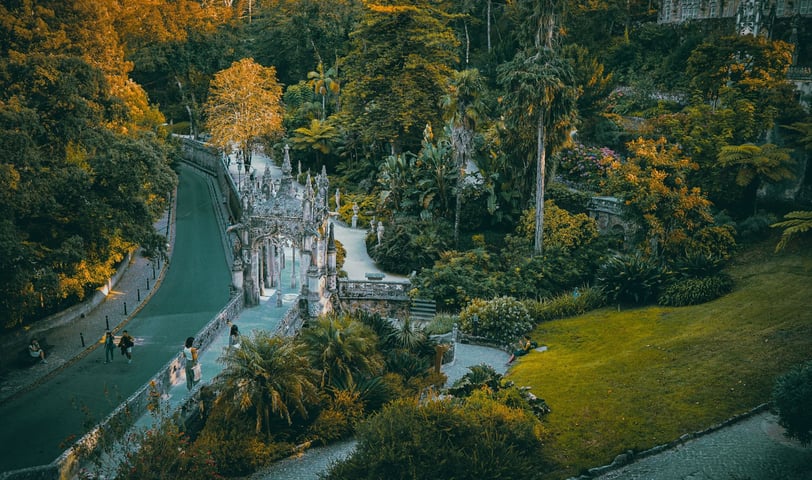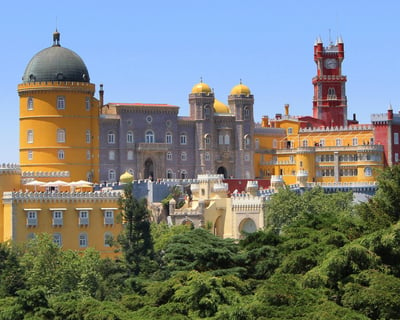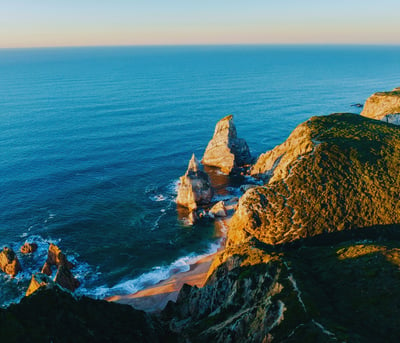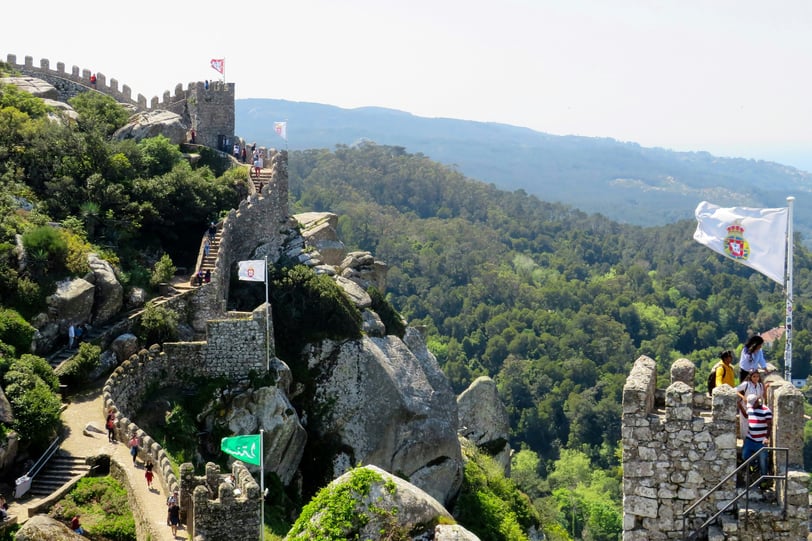Sintra Travel Guide: The House of Mists and Lost Lovers
A Dreamscape in the Sintra Hills
Sintra Old Town: A Labyrinth of History


Sintra Old Town unfolds in a tangle of cobblestone streets, where ivy spills from windows and cafés hum with the scent of pastéis de nata. The Palácio Nacional de Sintra, with its iconic twin chimneys, anchors the town—a medieval dreamscape of azulejo tiles and Gothic arches. Wander its alleys at dawn, when fog lingers, and every corner feels like a stanza from a forgotten poem.
The nearby Moorish Castle, perched on a rugged ridge, offers sweeping views of the Atlantic and rolling hills. Its weathered battlements, draped in silence, evoke centuries of conquest and solitude. “Sintra’s stones hold stories no book can tell,” says a local guide, her voice echoing in the morning haze.
Palácio da Pena: A Kaleidoscope of Color


High above Sintra Old Town, the Palácio da Pena crowns the hills in a riot of yellow, red, and blue. This 19th-century Romanticist palace, once a royal summer retreat, blends Gothic turrets, Moorish arches, and Manueline details. Its terraced gardens, thick with ferns and fountains, invite quiet strolls through a fairytale world.
Explore the staterooms (~EUR 14 entry) or linger in the Pena Park, where mist weaves through ancient oaks. “Pena is where imagination lives,” says a gardener, pruning roses beneath a gargoyle. This palace is Sintra’s vibrant heart, a canvas of dreams.
Perched at 500 meters in the lush hills of Portugal’s Serra de Sintra, just 25 km from Lisbon, Sintra is a town where time softens into mist. A UNESCO World Heritage Site, its pastel palaces, moss-draped alleys, and fog-kissed gardens whisper tales of poets, exiles, and dreamers lost to memory. From the vibrant Palácio da Pena to the enigmatic Quinta da Regaleira, Sintra is an invisible atlas of longing, navigated not by maps but by the heart.
Quinta da Regaleira: Secrets in Stone
The Quinta da Regaleira, a 20th-century estate, is Sintra’s enigma. Its gardens hide grottoes, fountains, and the Initiation Well, a spiral staircase plunging 27 meters into the earth—a symbol of rebirth or a portal to myth. Stone towers rise through fog, and moss clings to statues like whispered secrets.
Join a guided tour (~EUR 10) to unravel its esoteric symbols or wander solo to feel the past brush against the present. “This place feels alive,” says an artist, sketching the well’s curves. Quinta da Regaleira is where Sintra’s mysteries deepen.
Beyond the Old Town: Nature and Nostalgia
Just beyond Sintra’s whispering alleys, the Sintra-Cascais Natural Park beckons with forested trails and coastal cliffs. Hike the Santa Maria Trail (5 km, 2h, moderate) for panoramic views or visit the Monserrate Palace, its exotic gardens blooming with palms and camellias. The Cabo da Roca, Europe’s westernmost point, lies 15 km away, where the Atlantic roars under misty skies. Accessible via bus 403 from Sintra (30 min, ~EUR 4), it’s ideal for a coastal afternoon escape.
For culture, explore the Sintra Myths and Legends Interactive Centre, where tales of poets and exiles come alive. These escapes weave Sintra’s nature and lore into a tapestry of wonder.


Sintra Today: A Sanctuary of Stories
Despite 2 million annual visitors, Sintra Old Town retains its intimate charm. Sustainable tourism, like electric shuttles and guided hikes, preserves its UNESCO heritage. Locals keep traditions alive—bakers craft queijadas (cheese tarts), and artisans carve wooden saints in hillside workshops.
To capture its magic, wander the Old Town at dawn or sip coffee in Monserrate’s gardens. To weave your own story into Sintra’s misty tapestry, here’s what you need to know for your 2025 journey.
Practical Pleasures
To immerse in Sintra’s romantic charm in 2025, here are curated details with specific recommendations and costs:
How to Get There:
By Train: CP train from Lisbon (Rossio Station, 40 min, ~EUR 2.30/USD 2.50 one way). Book via cp.pt.
By Car: 25 km from Lisbon (~30 min), parking ~EUR 5/day. Use parquesdesintra.pt for parking info.
Local Transport: Sintra Old Town is walkable. Electric shuttles (434/435 routes, ~EUR 3/ride) connect palaces. Rent bikes (~EUR 10/day) for park trails.
Where to Stay:
Casa do Valle (Old Town): Cozy guesthouse with gardens, ~EUR 80–120/USD 85–130/night. Ideal for solo travelers.
Sintra Boutique Hotel (Old Town): Modern elegance, ~EUR 120–180/USD 130–195/night. Perfect for couples.
Tivoli Palácio de Seteais (near Old Town): 18th-century luxury, ~EUR 200–350/USD 215–375/night. Great for families.
Moon Hill Hostel (Old Town): Budget dorms, ~EUR 25–40/USD 27–43/night. Suits backpackers.
Where to Eat:
Café Paris (Old Town): Seafood risotto and pastéis de nata, ~EUR 10–20/USD 11–22/person. Historic ambiance.
Tacho d’Ouro (Old Town): Grilled sardines and queijadas, ~EUR 8–15/USD 9–16/person. Family-friendly.
InComum by Luis Santos (near Old Town): Modern Portuguese tasting menu, ~EUR 20–35/USD 22–38/person. Romantic vibe.
Bar do Binho (Old Town): Tapas and local wine, ~EUR 5–10/USD 5–11. Quick bites for hikers.
What to Do:
Palácio da Pena Tour: Explore the palace and park, ~EUR 14/USD 15/adult (parquesdesintra.pt). Open 09:30–18:30.
Quinta da Regaleira Guided Tour: Unravel esoteric symbols, ~EUR 10/USD 11/person (regaleira.pt). Book ahead.
Moorish Castle Visit: Hike the battlements, ~EUR 8/USD 9/adult. Open 09:00–18:00.
Sintra Myths and Legends Centre: Interactive storytelling, ~EUR 5/USD 5.50 (sintra.pt). Great for families.
Sketch in Monserrate Gardens: Set up a sketchbook or camera amid exotic blooms, free. Perfect for creatives embracing slow living.
Hike Santa Maria Trail: 5 km in Sintra-Cascais Natural Park, free. Moderate, 2h, ideal for adventurers.
Poetry at Palácio da Pena: Write or reflect in the palace gardens, free. A haven for writers seeking inspiration.
Best Time to Visit:
Seasons and Weather: March–May and September–October offer mild weather (15–22°C), ideal for hiking and palace visits. June–August is warm but crowded, while November–February brings mist and fewer visitors.
Key Festivals: The Sintra Festival (June–July) fills the Old Town with classical music and dance. The Festa de São Pedro (late June) lights up the streets with processions and fairs.
Who Will Love It:
Solo travelers seeking solitude, couples craving romance, families exploring history, adventurers hiking trails, and slow-living creatives inspired by mist and myth.
Budget Overview:
A one-week trip for two averages ~EUR 1,500/USD 1,600, covering mid-range accommodation (~EUR 100/USD 108/night), meals (~EUR 15–30/USD 16–32/day/person), transport (~EUR 20/USD 22/day), and activities (~EUR 20–50/USD 22–54/person). Budget travelers can spend ~EUR 60/USD 65/day/person.


Sintra at a Glance
Where Mists Weave Stories
Some stories refuse to fade, waiting to be found again. Among Sintra’s shadows, a traveler discovers love letters never sent in Travelers' Tales — "The Lost Letters of Sintra."
But Sintra is more than its past—it is a living stage where myths, literature, and tradition converge. To see how the town’s timeless spirit comes alive in festivals and cultural events, step into “Sintra 2025: Myths, Literature, and Cultural Festivals in Portugal’s Enchanted Hills.”
Sintra beckons to those who chase shadows—lovers strolling misty gardens, adventurers scaling castle ridges, creatives sketching in fog-draped groves. From the Old Town’s cobblestones to Pena’s vibrant spires, the town hums with echoes of longing and lore.
Join a Quinta tour (EUR 10/USD 11), hike the Santa Maria Trail (free), or write poetry at Pena to weave your thread into Sintra’s ethereal tapestry. Plan your 2025 journey, where mists and myths await your story. In the hush where fog meets twilight, Sintra holds a memory that never fades.
✉️ Contact:
Curated by TrueTrip Hub |
© 2025 Invisible Atlas — All rights reserved.
Invisible Atlas
Journey Beyond the Visible
invisible.atlas@truetriphub.com
